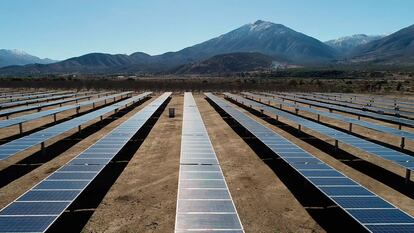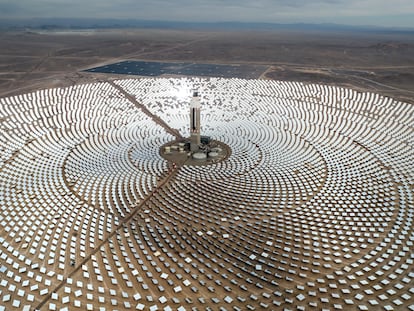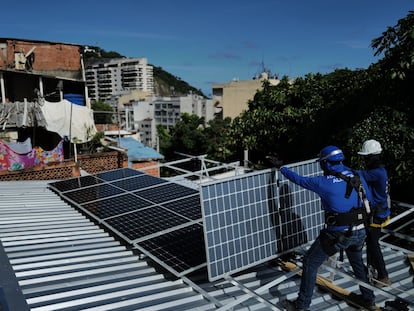Renewable energy boom in Chile takes a toll on electrical grid
Green energy companies in the South American country are demanding changes to current laws and improvements to the electrical distribution systems. This is so that they can receive correct remuneration, while ensuring that megawatts are not wasted

The renewable explosion offers a thousand and one environmental and economic possibilities, from long-awaited decarbonization, to a huge volume of cheap electricity that will change the paradigm of entire industries and countries. However, the new renewable reality – which is beginning to be compared in magnitude to the Industrial Revolution – also requires action on several fronts, so that the process of change is not stalled or slowed.
In Spain, for instance, the consultancy group Aurora Energy has warned that the expected growth of the electrical grid in the coming years is much less than what is needed to be able to supply all new renewable electricity. The same goes for Chile – the leader in the Americas in terms of the expansion of green energies. Not so long ago, former US Vice President Al Gore – an avowed environmentalist – described the South American country as “an inspiration to the world.”
Today, Chile’s renewable energy companies are pleading with the authorities to speed up investment in electrical distribution networks. They are also asking for an urgent market reform to guarantee that they receive the correct remuneration for the electricity that they sell every day.
Chile – one of the richest nations in Latin America – is also a regional power in the installation and generation of solar and wind energy. Last year, for the first time, both of these energies surpassed coal in electricity generation during a 12-month period, according to the National Electrical Coordinator (CEN) and the National Energy Commission (CNE). The goal is that 70% of energy consumed in Chile be green by 2030 – a figure on par with very few countries in the world. This is allowing Chile to position itself as a benchmark in the coming revolution in the energy world: that of green hydrogen.
For this sort of green miracle to become a reality, however, it still has to overcome a major hurdle: the development of the electric distribution network. It’s important both to ensure that the many green projects underway can distribute everything they produce, while minimizing wasted energy – a problem common to practically all countries where renewables are experiencing a boom.
“There’s a lack of [capacity in the distribution] network. The electrical system was designed 40 years ago: it was designed for that time, when hydroelectricity and coal were dominant. It’s [not equipped] for such a high amount of renewables, as [is the situation] today. There are already more renewables than distribution capacity,” says Miguel Arrarás, Chile’s director of Acciona Energía, a business dedicated to renewable energy solutions.
Added to this, he says, is the low remuneration that renewable energy generation receives. “During many hours, [when we produce] more energy than is required and transfer it to the grid, they pay us nothing. Fossil fuel plants, on the other hand, are receiving a higher price… even if they are physically next to solar or wind farms. It’s something that’s happening, especially in the north [of Chile] – where there are more than 2,000 zero-price hours each year – but also in the center and in the south.”
Late last year, Chile launched a $2 billion transmission line project that will connect the northern city of Antofagasta with Santiago, the capital. The first direct current line in the South American country will be about 870 miles long and will be able to transport up to 3,000 megawatts (MW) of energy. Conexión Kimal–Lo Aguirre is the company in charge of developing, building and operating the initiative, which is scheduled to become functional in 2029.
While it is being built, the Chilean Ministry of Energy – led by Diego Pardow – explains to EL PAÍS that, this year, they will present a request for “the development of urgent and necessary works for the transmission system,” via a special and exceptional mechanism established by the General Law of Electric Services. At the regulatory level, the focus is on granting “more [energy] certainty” by “clearly establishing the roles played by the different institutions and the remuneration, payment and ownership responsibilities of these instruments.” Lastly, the ministry says they are working on a special consensus for transmission, specifically for the expansion of projects that currently have “an inefficient system to be awarded and built.”
Arrarás says that Chile needs to prioritize three things for the expansion of renewable energy.
First, expand the network – a process that can take years. Second, manage the existing infrastructure “with more modern and flexible criteria, so that it can transport more energy.” And, third, “urgently” change the pricing mechanism “to avoid the paradox that polluting energies are receiving money and renewable energies are not.” He warns that, if the current scenario doesn’t change soon, the risk of bankruptcy in the green energy sector will be “very high.”
“We’ve already seen some cases and there will be more: there are many less-established companies that have a tight financial situation. A short-term solution must be sought… Chile’s energy transition and its credibility as a destination for energy investment could be in jeopardy, despite its great potential.”
In recent months, two renewable energy companies – María Elena Solar, a subsidiary of the Spanish firm Solarpack and Ibereólica Cabo Leones II – have filed for bankruptcy in Chile. Nine companies in the sector have sent a letter to the Ministry of Energy asking for the renewable energy regulations to be modified, particularly regarding the current pricing framework for renewable energy, so as to “reduce the risk of next-generation companies falling into financial insolvency.”
The country’s employers’ association – Generadoras de Chile – has an investment portfolio that includes $23 billion over the next five years in renewable energies: solar, wind, storage and green hydrogen. Claudio Seebach – executive president of the association – explains that, while the Kimal-Lo Aguirre project is being built, it’s necessary to invest in green energy storage.
“[Storage] allows you to capture solar or wind energy during the day and take advantage of the maximum potential to distribute it during hours when there is no sun or wind. [The storage systems] take a year to build,” he points out. The association’s generating companies are building close to 450 megawatts of electrical storage capacity, with another 1,600 MWs in development.
Meanwhile, the Ministry of Energy has assured the sector that President Gabriel Boric’s administration has a plan to rapidly implement the Storage Law – which came into force at the end of 2022 – and other measures that bolster this type of technology. The ministry also affirms that it has given priority to the Power Transfer Regulation, which establishes a clear table for the remuneration of energy storage. The public consultation has just concluded.
Seebach is urging the National Electrical Coordinator (CEN) to operate the network in a more efficient way to get the most out of it. In 2019, 200 gigawatts (GWh) were cut from Chile’s total energy production (80,000 GWh). In 2022, the level of waste reached 1,470 GWh.
“It’s a relatively small [amount of waste]... but it’s renewable energy,” the head of the business association laments. He warns of the need to speed up the approval of environmental impact studies, while ensuring that the different regulations have a principle of “coherence.”
Sign up for our weekly newsletter to get more English-language news coverage from EL PAÍS USA Edition
Tu suscripción se está usando en otro dispositivo
¿Quieres añadir otro usuario a tu suscripción?
Si continúas leyendo en este dispositivo, no se podrá leer en el otro.
FlechaTu suscripción se está usando en otro dispositivo y solo puedes acceder a EL PAÍS desde un dispositivo a la vez.
Si quieres compartir tu cuenta, cambia tu suscripción a la modalidad Premium, así podrás añadir otro usuario. Cada uno accederá con su propia cuenta de email, lo que os permitirá personalizar vuestra experiencia en EL PAÍS.
¿Tienes una suscripción de empresa? Accede aquí para contratar más cuentas.
En el caso de no saber quién está usando tu cuenta, te recomendamos cambiar tu contraseña aquí.
Si decides continuar compartiendo tu cuenta, este mensaje se mostrará en tu dispositivo y en el de la otra persona que está usando tu cuenta de forma indefinida, afectando a tu experiencia de lectura. Puedes consultar aquí los términos y condiciones de la suscripción digital.
More information
Archived In
Últimas noticias
There is as much life left to discover on planet Earth as that which is already known
Dozens presumed dead, around 100 injured in fire at Swiss Alps bar during New Year’s celebration
Is porn for women different from conventional porn? We spoke to those who make it
Cartagena de Indias is sinking: What can the city do to mitigate it?
Most viewed
- Reinhard Genzel, Nobel laureate in physics: ‘One-minute videos will never give you the truth’
- David King, chemist: ‘There are scientists studying how to cool the planet; nobody should stop these experiments from happening’
- Sinaloa Cartel war is taking its toll on Los Chapitos
- Oona Chaplin: ‘I told James Cameron that I was living in a treehouse and starting a permaculture project with a friend’
- The Interoceanic Train, the Mexican alternative to the Panama Canal










































